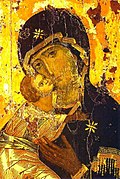Icon


An icon (from Greek: εἰκών, eikon, "image") is an image, picture, or representation which has a religious meaning. It is a sign or a likeness that stands for a real object or person.
Overview
Despite icon also referring to images of other religions, it is most often used to describe a painting on a wooden panel that has been done in the Orthodox Christian tradition, and may also be used for carved ivory panels and panels of silver or gold.
Examples
These icons show a holy being such as Jesus, Mary, a saint or an angel. They also show scenes from the Bible, such as the Crucifixion, and scenes from lives of Christian saints.
Orthodox Christianity
In Orthodox Christianity, an icon is seen as a window via which a person can get a view of God's truth.
Orthodox Christian icons
History
The traditional way of making an icon was used in Egypt in Early Christian times to make portraits of dead people to use for their funerals. Like icons, these funeral portraits were done on a wooden panel and the paint was mixed with yolk of egg. From the time that Christianity was made legal by Constantine the Great in the early 300s, artists began to use the same method for painting holy pictures.
It was always hoped that a painting would last for a long time, so everything had to be very carefully prepared. A board had to be chosen that would not crack or warp (bend), and which did not have any knotty bits that might fall out.
The board was sanded smooth and then coated with a gluey paint called "size" which would hold the coloured paint well, but stop the expensive colours from being soaked up by the wood. The artist would prepare the paints very carefully. Some of the colours were made from gound-up semi-precious stones. Others were made from chemicals.
Production
Preparation
Before the artist could start on the panel, he had to prepare the design. It was not important for the artist to think of something new and different. It was much more important that he could copy another icon very accurately. The same designs were used over and over.
Despite all icons being seen as a window to Heaven, some icons were believed to have special properties. It was believed that praying and lighting candles before some icons would bring healing, or the help of the saint who was shown in the picture. These icons became very famous and were often copied.
Painting
After the artist had drawn the design onto the surface of the size in thin green or brown paint, he would put the paint on in layers, building up the colours bit by bit. Most of the colours were quite transparent and this made the painting look glowing.
Completion
When the figures were finished the artist would set the work in a wooden frame and cover the background with a little pieces of gold leaf that had been beaten into very thin sheets.[clarification needed] When a candle was lit near the icon, it shone on the gold surface and made the figures stand out.
Icons in other religions
Throughout history, some religions, such as Christianity and Hinduism, have often used icons such as paintings and statues, while others, such as Judaism and Islam, do not often use icons due to concerns over idolatry.
Hinduism
In Hinduism, there is much use of sacred objects because there is a belief in murti, the idea that the Spirit of God can be present in an icon (or holy object).
Icon Media
The Ladder of Divine Ascent depicts monks ascending to Jesus in heaven in the top right. 12th century, Saint Catherine's Monastery.
Russian icon of the Holy Trinity
The icon of St Nicolas carved in stone (between c. 12 and 15th centuries), at the Radomysl Castle, in Ukraine
Luke painting the Theotokos of Vladimir (16th century, Pskov)
A rare ceramic icon depicting Saint Arethas (Byzantine, 10th century)
Image of the Saviour Not Made by Hand: a traditional Orthodox iconography in the interpretation of Simon Ushakov (1658).
Christ and Saint Menas, 6th-century Coptic icon from Egypt (Musée du Louvre)
The oldest surviving icon of Christ Pantocrator, encaustic on panel, c. 6th century (Saint Catherine's Monastery, Mount Sinai)
The "Theotokos of Vladimir" icon (12th century) symbol of Russia
12th-century icon of Archangel Gabriel from Novgorod, called The Angel with Golden Hair, currently exhibited in the State Russian Museum
Related pages
Other websites
| Wikimedia Commons has media related to Lua error in Module:Commons_link at line 62: attempt to index field 'wikibase' (a nil value).. |
Pictures
- Online exhibitions of over 1000 ancient icons Archived 2009-02-18 at the Wayback Machine
- Icons of Mount Athos Archived 2006-12-11 at the Wayback Machine
- Russian Icons from 12th to 18th century Archived 2007-01-04 at the Wayback Machine
- Greek Orthodox Archdiocese of America: Icons Archived 2006-12-11 at the Wayback Machine
- Gallery of icons, murals and mosaics (mostly Russian) from 11th to 20th century
- Two 19th century Russian icons depicting Saint Nicholas
- Sacred Icons painted by the famous artist David Ongaro Archived 2007-05-01 at the Wayback Machine
Orthodox
- The Iconic and Symbolic in Orthodox Iconography
- Church of the Nativity - Explanation of Orthodox Christian Icons Archived 2007-06-22 at the Wayback Machine
- On the difference of Western Religious Art and Orthodox Iconography Archived 2015-10-09 at the Wayback Machine
- Romanian glass icons Archived 2006-12-16 at the Wayback Machine
Catholic
- Catholic Encyclopedia: "Veneration of Images"
Protestant
- Theology of Icons: a Protestant Perspective Archived 2007-01-15 at the Wayback Machine










